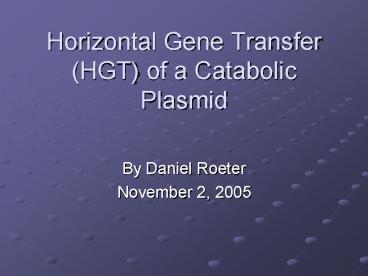Horizontal Gene Transfer HGT of a Catabolic Plasmid - PowerPoint PPT Presentation
1 / 16
Title:
Horizontal Gene Transfer HGT of a Catabolic Plasmid
Description:
Models antibiotic resistances acquired by bacteria ... Genes can be horizontally transferred via conjugation, transformation, and transduction ... – PowerPoint PPT presentation
Number of Views:225
Avg rating:3.0/5.0
Title: Horizontal Gene Transfer HGT of a Catabolic Plasmid
1
Horizontal Gene Transfer (HGT) of a Catabolic
Plasmid
- By Daniel Roeter
- November 2, 2005
2
My Research
- Studying HGT of a catabolic gene that degrades
parathion - Models antibiotic resistances acquired by
bacteria - Much of this paper is very similar to Brandons
and my research
3
Why was this Paper Written?
- Lack of study data on transfer of a catabolic
plasmids - Differs from heavy metal/antibiotic resistance
plasmids in size and copy number - Research on this subject could lead to
bioaugmentation and/or bioremediation in soil
4
Background Information
- Genes can be horizontally transferred via
conjugation, transformation, and transduction - Transfer had to be between 2 bacterial strains
that could degrade 2,4-dichlorophenoxyacetic
(2,4-D) acid - This requires chromosomally encoded maleylacetate
reductase
5
The Bacterial Strains
- Donor Alealigenes eutrophus JMP134, contains
pJP4 plasmid, (2,4-D Hgr Kms) - Recipient Variovorax paradoxus, (2,4-D- Hgs Kmr)
- Plasmid Being Transferred pJP4 that contains
(1) the catabolic enzyme that degrades
2,4-dichlorophenoxyacetic (2,4-D) acid and
(2)resistance to Hg - All growth on media was done with both donor and
recipient cells
6
The Different Media
- PY Agar
- Abiotic Soil (autoclaved)
- Biotic Soil
7
The Different Selectors
- PYM PY Mercury (Hg) ? selects for donors and
transconjugants (plasmid transferred) - PYK PY Kanamycin ? selects for recipients and
transconjugants - PYMK PY Hg Kanamycin ? selects for only
transconjugants
8
Confirmation of Transfer Procedure
- The transconjugants from the PYMK media were
grown in a solution where 2,4-D was the only
carbon source (green to yellow) - Ability to grow in Hg
- PCR of the Gene and visualization
- Plasmid analysis and visualization
9
Growth on Soil Media
- Grown on both sterile (abiotic) and non-sterile
(biotic) soil - Procedure for both soils was basically the same
- Samples were taken from the sterile soil
immediately following addition to soil and at
days 1,2,3, and 8 - Non-sterile were taken immediately and at days 1
and 2 - Suspected trasconjugants were confirmed in the
same way as before
10
- In all experiments, the growth on solid agar was
1 transconjugant per 103 parents cells (1/103) - 75 suspected transconjugants were confirmed as
before
11
- Demonstrates that that during the transfer from
media to plate for transconjugant analysis (done
at 4C) little or no HGT occurred to spike the
numbers - This is called plate mating, did not occur due
to pre-incubation at 4C
12
- Results (sterile)
- Donor and recipient cells remained constant
- Transconjugant number increased in the 1st day
and remained fairly constant - Transfer of 1 transconjugant per 105 parents
cells (1/105)
- Again transconjugants were confirmed
13
- Results (non-sterile)
- Donor and recipient cells remained constant in
day 1 and 2, but then declined - Transconjugant number were BDL until 6th day
- Procedure was repeated with 2,4-D amended soil to
increase the conc. of donors and transconjugants
- Change produced transconjugants within 2 days
- Transfer of 1 transconjugant per 106 parents
cells (1/106) even though soil was amended - Transconjugants were confirmed
14
Discussion of Results
- Transfer did occur and was confirmed by
transconjugant analysis - Growth on agar media overestimates HGT frequency
- Growth on sterile soil highlights abiotic
stresses - Abiotic stresses are unique to the particular soil
15
Discussion of Results
- Non-sterile soil highlights biotic stresses
16
The Bottom Line
- Transfer of the large catabolic plasmid does
occur, but its frequency is greatly reduced in
soil - HGT effective over long period of time, but not
effective with introduced donors































